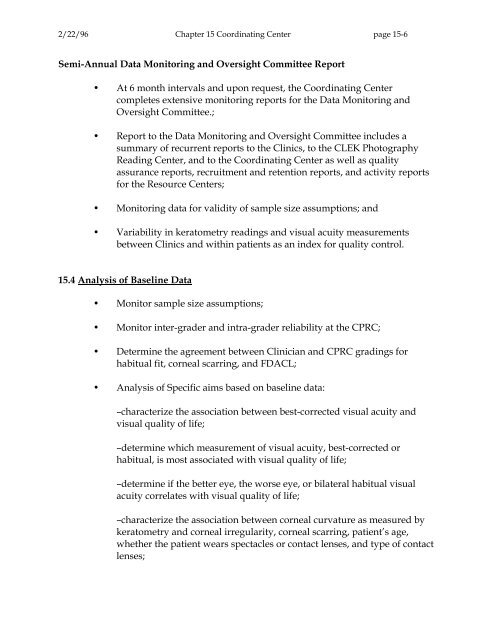OM t of c.iii - Vision Research Coordinating Center - Washington ...
OM t of c.iii - Vision Research Coordinating Center - Washington ...
OM t of c.iii - Vision Research Coordinating Center - Washington ...
You also want an ePaper? Increase the reach of your titles
YUMPU automatically turns print PDFs into web optimized ePapers that Google loves.
2/22/96 Chapter 15 <strong>Coordinating</strong> <strong>Center</strong> page 15-6<br />
Semi-Annual Data Monitoring and Oversight Committee Report<br />
• At 6 month intervals and upon request, the <strong>Coordinating</strong> <strong>Center</strong><br />
completes extensive monitoring reports for the Data Monitoring and<br />
Oversight Committee.;<br />
• Report to the Data Monitoring and Oversight Committee includes a<br />
summary <strong>of</strong> recurrent reports to the Clinics, to the CLEK Photography<br />
Reading <strong>Center</strong>, and to the <strong>Coordinating</strong> <strong>Center</strong> as well as quality<br />
assurance reports, recruitment and retention reports, and activity reports<br />
for the Resource <strong>Center</strong>s;<br />
• Monitoring data for validity <strong>of</strong> sample size assumptions; and<br />
• Variability in keratometry readings and visual acuity measurements<br />
between Clinics and within patients as an index for quality control.<br />
15.4 Analysis <strong>of</strong> Baseline Data<br />
• Monitor sample size assumptions;<br />
• Monitor inter-grader and intra-grader reliability at the CPRC;<br />
• Determine the agreement between Clinician and CPRC gradings for<br />
habitual fit, corneal scarring, and FDACL;<br />
• Analysis <strong>of</strong> Specific aims based on baseline data:<br />
–characterize the association between best-corrected visual acuity and<br />
visual quality <strong>of</strong> life;<br />
–determine which measurement <strong>of</strong> visual acuity, best-corrected or<br />
habitual, is most associated with visual quality <strong>of</strong> life;<br />
–determine if the better eye, the worse eye, or bilateral habitual visual<br />
acuity correlates with visual quality <strong>of</strong> life;<br />
–characterize the association between corneal curvature as measured by<br />
keratometry and corneal irregularity, corneal scarring, patient’s age,<br />
whether the patient wears spectacles or contact lenses, and type <strong>of</strong> contact<br />
lenses;
















